Indoor air quality monitoring is the future of healthy, smart buildings. 91 percent of U.S. consumers consider healthy indoor air quality (IAQ) important during COVID-19 and 76 percent would feel more comfortable entering buildings knowing IAQ was being monitored.

*Study and image by Carbon Lighthouse.
Pandemic aside, poor indoor air has been shown to reduce cognitive performance, cause fatigue and irritation, and even increase your heart and respiratory disease risk.
The case for clean air is a long one, but how do you ensure your IAQ is up to par?
Well, what gets measured, gets managed… and indoor air quality is no different.
In this guide, we’ll cover everything you need to know about indoor air quality monitoring so you can assess, improve and maintain clean air for years to come.
Table of Contents
- What is Indoor Air Quality Monitoring?
- Starting an Indoor Air Quality Monitoring Project
- Understanding Indoor Air Quality Monitoring Systems
- How to Select the Best Indoor Air Quality Monitoring Devices
- Common Indoor Air Quality Monitoring Services
What is Indoor Air Quality Monitoring?
Indoor air quality monitoring is the process of gathering continuous data on the particles, gasses, and chemicals present in your air. The goal of collecting this data is to identify trends, spot problem areas, and make adjustments accordingly. Building owners, facility managers, and technicians may introduce monitoring to reduce airborne disease risk, identify areas that inhibit occupant wellbeing, and detect anomalies like mold growth.
What exactly are you monitoring?
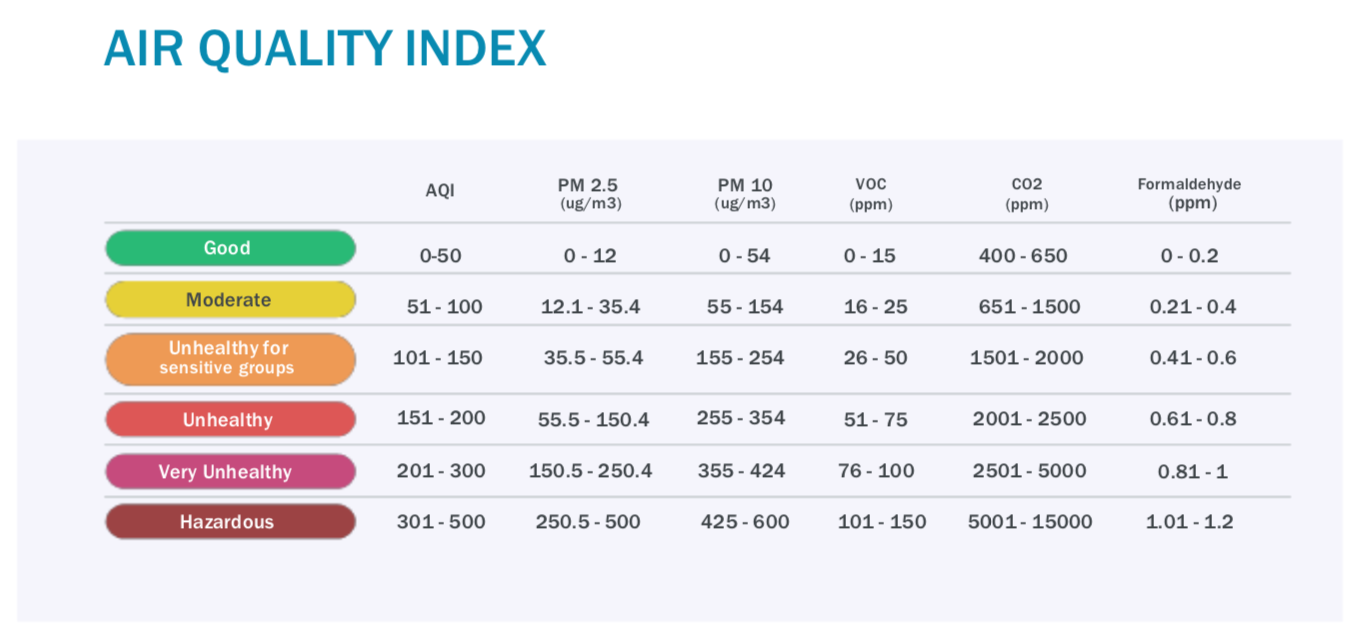
At qlair, we track the EPA’s Air Quality Index (AQI). This index was created to assess the overall health of your indoor air and tracks common indoor pollutants that affect human health. Common indoor air pollutants include carbon dioxide (CO2), particulate matter (PM2.5 and PM10), volatile organic compounds (VOCs), as well as various others. Factors like temperature and humidity are also important air quality parameters to consider monitoring over time. For a detailed list of the IAQ standards and recommendations, check out our 2021 Guide to the Indoor Air Quality Standards that Matter.
What do you need to start monitoring?
There are typically three aspects to IAQ monitoring:
- Hardware: Sensors, detectors, and monitors that track indoor air pollutants and parameters.
- Software: The monitoring system used to track and analyze IAQ data over time.
- Services: Processes for using data analysis to resolve air quality issues.
Starting an Indoor Air Quality Monitoring Project
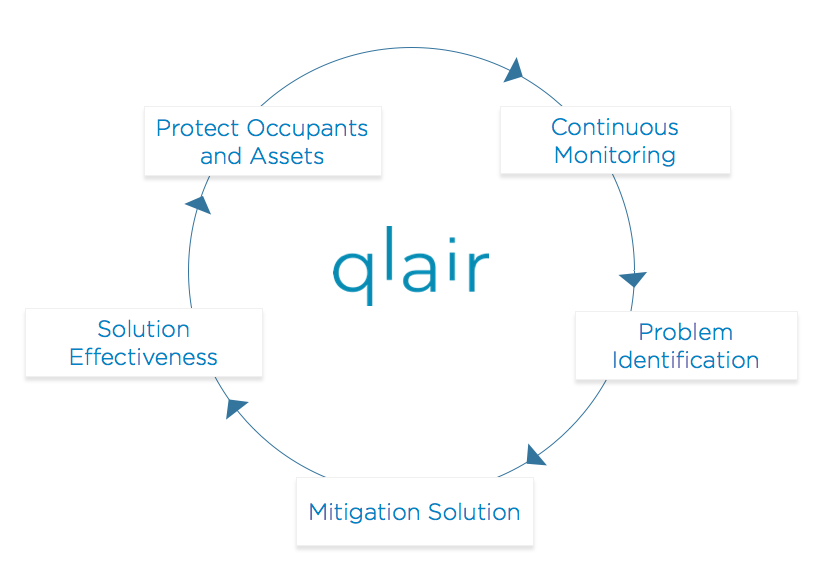
Let’s first discuss a couple of common indoor air quality monitoring methods.
- Continuous or real-time indoor air quality monitoring is the process of gathering IAQ data 24 hours per day, 7 days per week. This is accomplished using IAQ sensors that collect minute-by-minute readings of your indoor air.
- Indoor air quality testing differs greatly. Testing your indoor air quality is not the same as continuously monitoring your indoor air quality. Air quality testing is a one-off occurrence. A professional typically uses a handheld probe, getting a snapshot of the air quality at a single point in time.
For the purpose of this guide, we will be focusing on real-time IAQ monitoring. Our team at qlair recommends continuous data collection because air quality is dynamic… and so is your building. Daily activities and changes to operations can cause significant changes in your IAQ.
Now, let’s quickly review the indoor air quality monitoring instruments you will need to have a successful project.
- A network of reliable indoor air quality sensors placed strategically throughout your facility,
- An accurate IAQ monitoring system using IoT (Internet of Things) capabilities, and
- A process for analyzing data to come up with best solutions for your unique situation.
With your equipment and processes in place, you can begin to define your plan of attack. This 5-step plan is a fool-proof way to ensure you get accurate and useful data that translates into actual improvements.
1. Identify Goals and Scope
Your current budget, desired outcomes, and current issues will play a key role in starting your project. Monitoring every space in your building from the start is a great way to get a holistic view of building health, but it’s not required. There are many ways to get started.. it just matters that you start.
Sometimes the topic of monitoring comes up because you have a specific problem you’re looking to solve. There are several air quality issues that can be resolved with the help of IAQ data, with common examples including:
- Monitoring indoor pollutant levels before and after the installation of a clean air system.
- Tracking down the cause of a problem (odor, headaches, etc.) by identifying the source of indoor pollution.
- Optimizing ventilation based on occupancy and activity to provide better IAQ and reduce energy costs.
Waiting until you have a serious problem is not the only case for IAQ monitoring. In fact, its often too late. Starting before you have a problem will set you up to resolve issues proactively. Here are some good questions to ask when identifying your goals and scope:
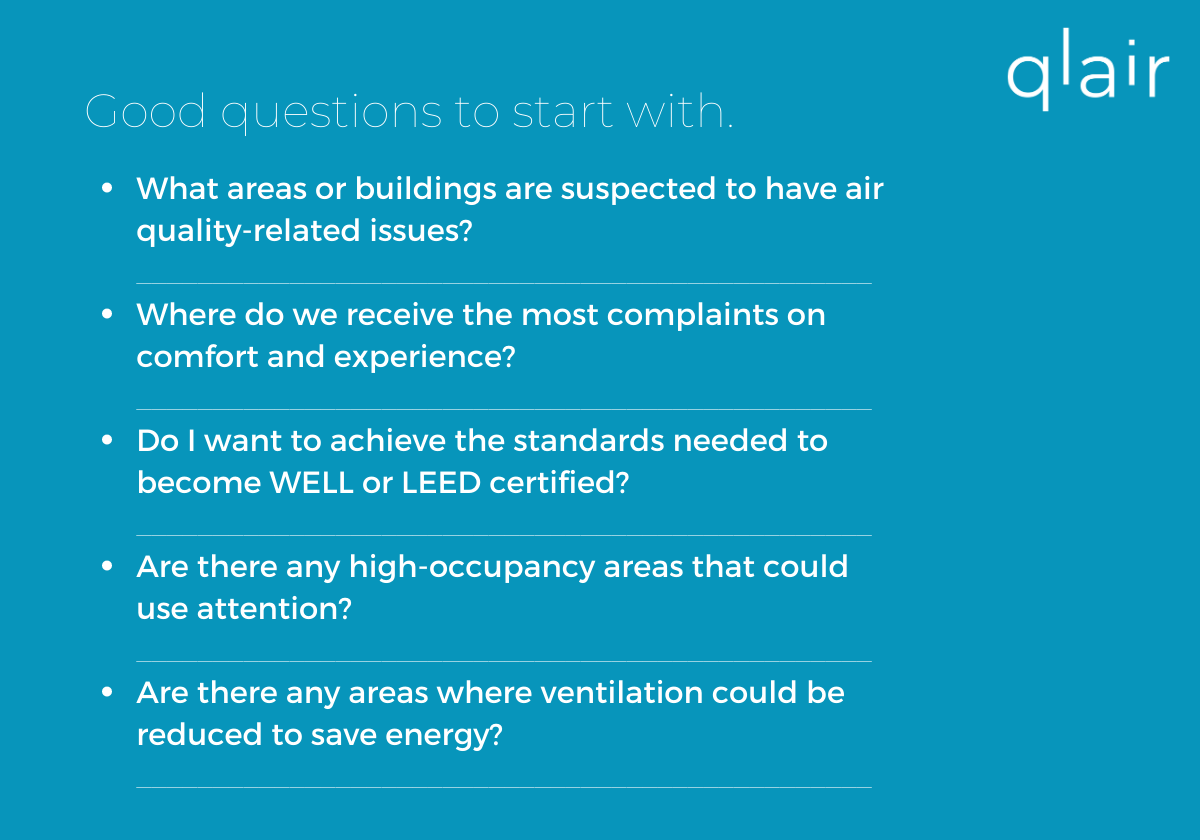
2. Installing Your IAQ Sensors
When deciding on the location of your sensors, it is important to consult experts. Highly accurate sensors can be sensitive, and installing them incorrectly can lead to problematic data. However, there are a few important things to consider before deciding installation.
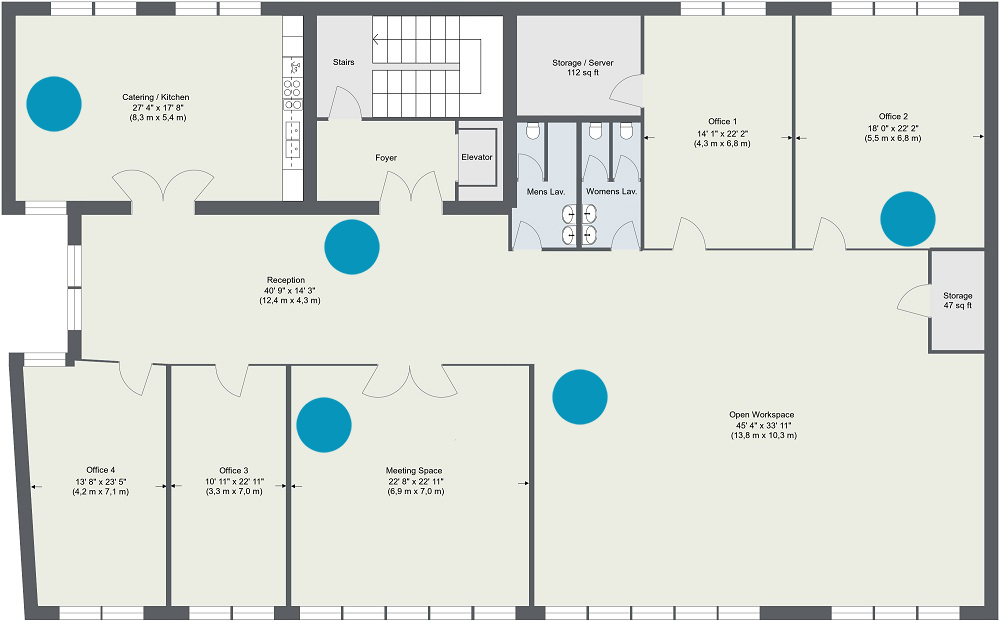
In this section, we will use the qlair SPS 208 IAQ Sensor as an example for technical specifications.
- Start with areas suspected to have indoor air quality problems.
- Consider that sensors have an accurate measuring range of up to 5,000 squared feet.
- Ensure adequate WiFi access to connect sensors.
- Consider installation method – recessed outlets will provide cordless installations.
3. Identifying Trends and Problem Areas
Gathering data is only half of the process. The real value in IAQ monitoring comes from turning this data into actionable insights to improve IAQ. Tracking pollutant levels over time to identify when and where air quality exceeds healthy levels is the best way to do this.

Once you have gathered an adequate dataset, it is time to analyze trends and spot problem areas. Indoor air quality can be affected by a variety of activities, some of which including:
- Leaking or improperly contained chemical containers.
- Increased outdoor air pollution due to pollen, wildfire smoke, and seasonal changes.
- New equipment and machinery that produce harmful byproducts.
- Higher than usual occupancy rates impeding fresh air levels.
Using an indoor air quality monitoring system, it should be simple to spot common spikes and irregularities. The qlair monitoring system does this for you – using predictive analytics to notify you when air quality reaches unsafe levels.
4. Implementing Optimization & Remediation Strategies
Once you have identified problem areas within your facility, it’s time to develop a plan to resolve them. This step is arguably the most important step in the entire process. Here is where you will make valuable changes to building operations and management to improve your indoor air.
First, it is important to know that each air quality problem you confront will have unique solutions and strategies to remediate them.
Ventilation-Related Example
Problem: Let’s say your recreational facility gets complaints of stuffy indoor air during peak occupancy hours – 2:00 PM to 6:00 PM. It is likely that you will find high CO2 levels during the same time period.
- Solution: Increasing ventilation rates to improve fresh air levels during high-occupancy times may be warranted. To balance (or even reduce) energy costs, you can use the same IAQ data to reduce ventilation during periods where healthy air can be maintained without it.
Filtration-Related Example
Problem: PM2.5 levels are a great indicator of how well your filtration system is performing. During the pandemic, filtration has become more important than ever. Experts from ASHRAE and the CDC recommending key changes to filter maintenance.
They suggest increasing filtration to MERV-13 or the highest compatible class for your system to ensure indoor spaces are achieving an adequate number of air exchanges per hour.
- Solution: If you can’t upgrade your filters to the highest efficiency levels, you may find that healthy PM2.5 levels are not being maintained. If this occurs, installing a portable air cleaner in the space is recommended by ASHRAE and is a great way to reduce contaminant levels. IAQ data will point you to the right space to place your system and ensure it works.
Source Control Example
Problem: Various indoor pollutants can have a noticeable impact on humans. If there is a chemical spill in the basement of your facility – where the lab is – odors and harmful contaminants may enter the ventilation system and spread.
- Solution: A typical example of pollutant spreading is in hospitals, where lab materials can emit VOCs when left improperly contained. Perhaps there is an odor problem on the second floor. When analyzing your data, you may find that VOC levels have increased on both the second floor and basement. If the basement is where your chemicals are stored, you know to inspect the area for problems. Once the root cause is identified, you can eliminate the source and reduce pollutant concentrations.
5. Ensuring Your Efforts Paid Off
The goal of indoor air quality monitoring is to take action on your IAQ data and prove that your efforts have paid off. So, once you’ve implemented a new strategy to resolve a problem, its important to keep track of your progress.
Mini-Case Study: Using IAQ Data to Prove Air Purification Success

Introduction
In this case, filters alone did not provide adequate defense against outdoor air pollution. Our team recommended a portable air cleaning device with HEPA filtration to reduce particulate levels. We compared historical data to the data gathered after installation to measure results.
Process
- The SPS 208 IAQ sensor was installed in the space, tracking real-time changes in particulate matter (PM2.5 and PM10).
- An air cleaner with a pre-filter, a HEPA filter, and a UV-C germicidal lightbulb was installed on July 8th, 2020.
- Data collection and analysis spanned several weeks before and after installation.
Results
The air purification unit significantly reduced particulate matter levels within the enclosed space when operating. We assessed the air purification unit’s efficiency using Data from continuous indoor air quality monitoring.
Understanding Indoor Air Quality Monitoring Systems
Indoor air quality monitoring systems may seem daunting, but an intuitive software will show you the data you need to know simply and effectively. Many IAQ sensors come with software access available on the web and a mobile app. If you use qlair, you can expect to see features that include:
- Real-time data visualization on monitored spaces.
- Notification and alerts based on air quality changes.
- In-depth reporting and analytics.
- Index scores to indicate mold risk, airborne disease transmission risk, and more.
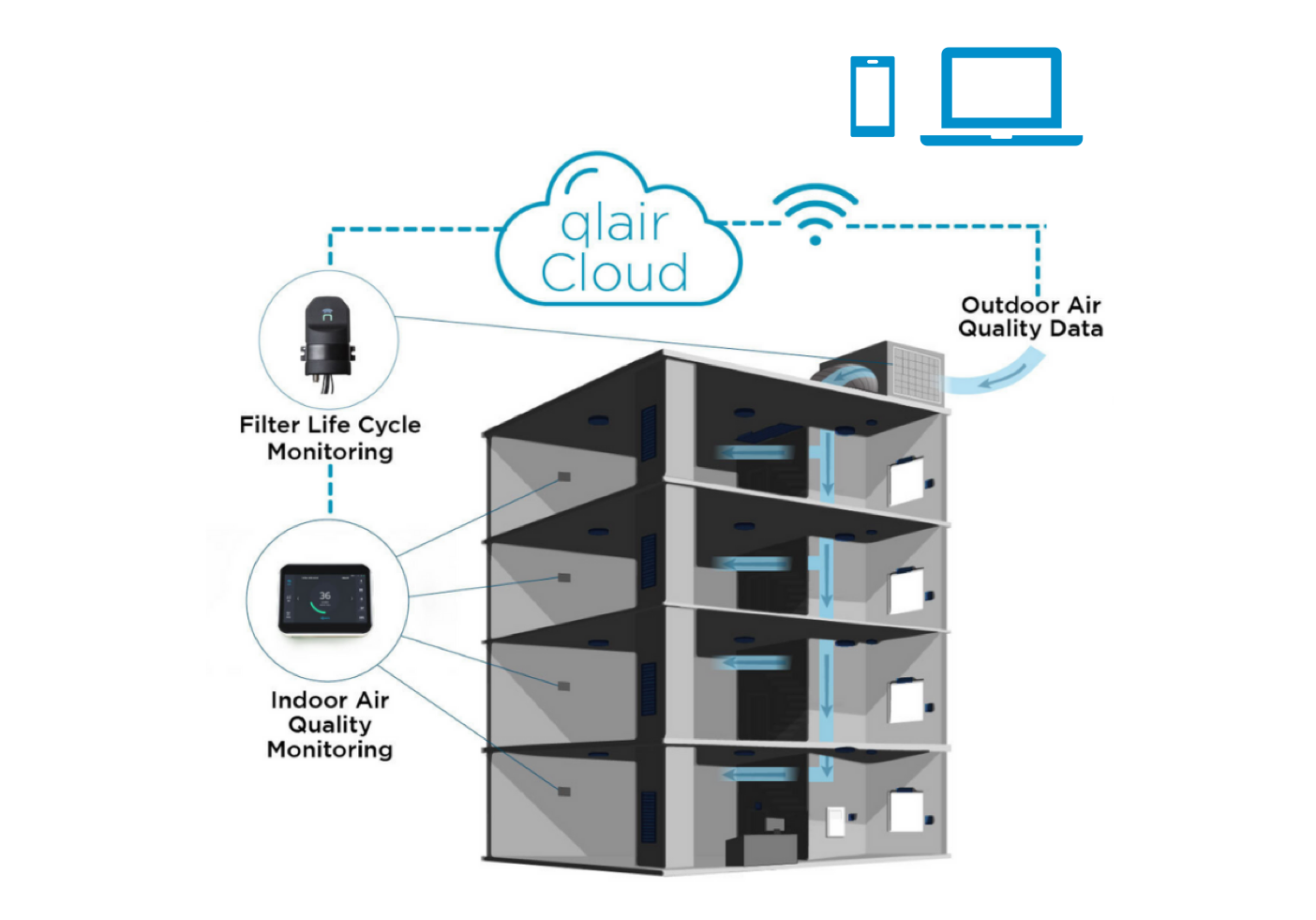
Indoor air quality monitoring systems leverage the Internet of Things (IoT) technology. The smart air quality sensors and web-based applications are connected to the cloud via a WiFi network, transferring data via a secure API. This is what allows you to view your air quality information in real-time.
How to Select the Best Indoor Air Quality Monitoring Devices
Start with what you want to track.
Indoor air quality monitoring devices come in a variety of measuring capacities. Single-pollutant sensors collect data on only one air quality parameter, with common types including CO2, PM2.5, and VOC-only sensors.
For those looking to gather data on several parameters related to building health at once, multi-pollutant sensors are your best option.
![]()
Multipollutant sensors track several indoor air quality parameters at once, providing a more in-depth look at your indoor air. The monitor showed above track six parameters: PM2.5, VOCs, Temperature, CO2, and Humidity.
Consider system requirements & accessibility
When deciding on which sensor to go with, it is important to consult with your IT department. Most digital air quality monitors require an internet connection through a secure WiFi network. If you’re looking to install at a commercial, education, or healthcare space, here are some things you’ll want to consider:
- Connecting sensors to a secure WiFi network separate from other workplace devices.
- Identifying installation sites with recessed power outlets to conceal wiring.
- Deciding whether you want to read IAQ data on the device or use a discrete sensor.
Prioritize high-accuracy readings.
If you’re investing in an indoor air quality monitoring project, you’ll want to make sure you’re getting data you can trust.
Standard Indoor Air Quality Monitoring Services
When considering vendors, partners, and teammates for an indoor air quality monitoring project, there are certain services you should look for to have a successful experience.
- Installation Support: Sometimes, in-house technicians are not adequately equipped to perform a large installation project. Getting support from expert electricians and engineers will be a vital aspect of the project to consider.
- IAQ Consultation: If you work with a team like qlair, you can expect to review your indoor air quality data with experts. During these sessions, you can ask questions, receive recommendations, and ensure you are on track to hitting your goals.
- Reporting and Alerts: To take a proactive approach to managing IAQ, ensure you have access to regular reports and alerts. Reports are a great way to keep you on track and showcase progress to stakeholders. Setting up custom alerts will also come in handy. Getting notified in real-time when problems occur leads to a hands-off approach to IAQ.
Start Your Next IAQ Monitoring Project with Experts
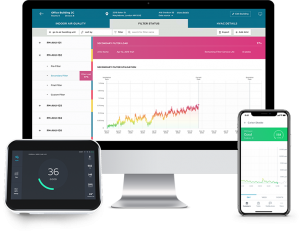
If you’re looking to take control of your building’s health and safety in 2021, qlair is the right partner for you. With award-winning indoor air quality sensors and an intuitive monitoring system, tracking your air quality’s health and resolving issues has never been easier. Learn more about indoor air quality monitoring or schedule a product tour to see what solutions may be right for your situation.
